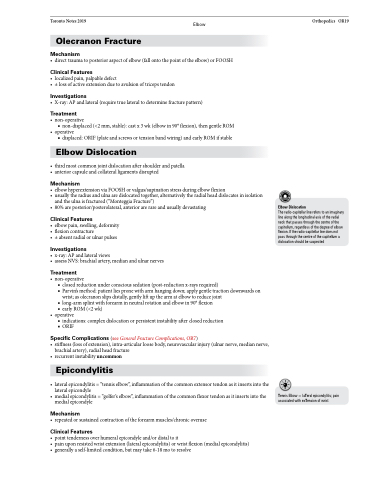Page 953 - TNFlipTest
P. 953
Toronto Notes 2019 Elbow Olecranon Fracture
Mechanism
• directtraumatoposterioraspectofelbow(fallontothepointoftheelbow)orFOOSH
Clinical Features
• localizedpain,palpabledefect
• ±lossofactiveextensionduetoavulsionoftricepstendon
Investigations
• X-ray:APandlateral(requiretruelateraltodeterminefracturepattern)
Treatment
• non-operative
■ non-displaced (<2 mm, stable): cast x 3 wk (elbow in 90° flexion), then gentle ROM
• operative
■ displaced: ORIF (plate and screws or tension band wiring) and early ROM if stable
Elbow Dislocation
• thirdmostcommonjointdislocationaftershoulderandpatella • anteriorcapsuleandcollateralligamentsdisrupted
Mechanism
• elbowhyperextensionviaFOOSHorvalgus/supinationstressduringelbowflexion
• usuallytheradiusandulnaaredislocatedtogether,alternativelytheradialheaddislocatesinisolation
and the ulna is fractured (“Monteggia Fracture”)
• 80% are posterior/posterolateral, anterior are rare and usually devastating
Clinical Features
• elbowpain,swelling,deformity • flexioncontracture
• ±absentradialorulnarpulses
Investigations
• x-ray:APandlateralviews
• assessNVS:brachialartery,medianandulnarnerves
Treatment
• non-operative
■ closed reduction under conscious sedation (post-reduction x-rays required)
■ Parvin’s method: patient lies prone with arm hanging down; apply gentle traction downwards on
wrist; as olecranon slips distally, gently lift up the arm at elbow to reduce joint
■ long-arm splint with forearm in neutral rotation and elbow in 90° flexion ■ earlyROM(<2wk)
• operative
■ indications: complex dislocation or persistent instability after closed reduction ■ ORIF
Specific Complications (see General Fracture Complications, OR7)
• stiffness(lossofextension),intra-articularloosebody,neurovascularinjury(ulnarnerve,mediannerve,
brachial artery), radial head fracture
• recurrentinstabilityuncommon
Epicondylitis
• lateralepicondylitis=“tenniselbow”,inflammationofthecommonextensortendonasitinsertsintothe lateral epicondyle
• medialepicondylitis=“golfer’selbow”,inflammationofthecommonflexortendonasitinsertsintothe medial epicondyle
Mechanism
• repeatedorsustainedcontractionoftheforearmmuscles/chronicoveruse
Clinical Features
• pointtendernessoverhumeralepicondyleand/ordistaltoit
• painuponresistedwristextension(lateralepicondylitis)orwristflexion(medialepicondylitis) • generallyaself-limitedcondition,butmaytake6-18motoresolve
Orthopedics OR19
Elbow Dislocation
The radio-capitellar line refers to an imaginary line along the longitudinal axis of the radial neck that passes through the centre of the capitellum, regardless of the degree of elbow flexion. If the radio-capitellar line does not pass through the centre of the capitellum a dislocation should be suspected
Tennis Elbow = laTeral epicondylitis; pain associated with exTension of wrist


